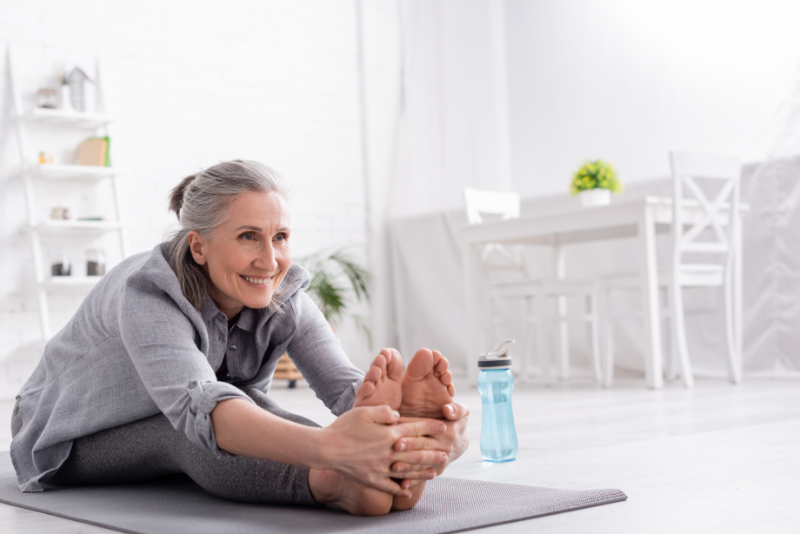
The Benefits of Stretching
Adding physical activity to your daily routine can enhance your healthy lifestyle. But that doesn't mean you need to spend hours at the gym. One of the easiest and most beneficial things you can do for your body is to stretch.
In this article, you'll learn the benefits of stretching, different types of stretches, the best time to stretch, and more!
What are the benefits of stretching?
Increases flexibility and range of motion:
Stretching is the best thing you can do to improve your flexibility, which is great for your overall health.
By increasing flexibility and your body’s range of motion, you’ll have more freedom of movement to help you perform everyday tasks. More flexibility could also lead to improved physical performance when exercising.
Increases blood flow to muscles:
Stretching regularly may help with blood circulation. Improved circulation can shorten recovery time and muscle soreness after strenuous exercise.
Reduces stress and tension:
One of the effects of stress on your body is muscle tightness. This can lead to pain, especially in the neck, shoulders, back, and head.
By stretching, you can loosen certain muscle groups that are most affected by stress-induced tightness.
Reducing stress and tension can indirectly improve your weight loss journey. Stretching can help create a sense of calmness and potentially relax your body. It is a much healthier way to deal with stress than leaning on unhealthy snacks to improve your mood.
Improves posture:
Developing poor posture happens over time and is a common issue for people who sit hunched over a desk for work.
If your spine is curved for long periods of time, your muscle will overcompensate to stabilize the bones and joints in your back.
Stretching may help lengthen certain muscles, allowing you to sit taller and straighter.
Stretching techniques
Active Stretching:
When you use your own muscles to provide resistance. With an active stretch, you're moving or contracting one muscle to stretch another.
A prime example of this is yoga. Think of yoga as the yin and yang stretching. This kind of stretching is great to do as a warmup before high-intensity workouts or weight training.
Static Stretching:
When you extend your muscles to the furthest point in a certain position, hold that position, and breathe for about 30 seconds. It is the most common form of stretching and is likely what you visualize when you hear the term "stretching".
This type of stretching increases flexibility.
Dynamic Stretching:
Active movements that cause your muscles to stretch, but the stretch is not held in the end position. Dynamic stretching is usually done to warm up your muscles before exercising.
Self-Myofascial Release:
Involves using tools like rollers, tennis balls, or other objects to target different trigger points or knots in your muscles.
Gentle pressure with these stretching tools can help relieve pressure or "release" the knot you feel in your muscles.
When is the best time to stretch?
Listen to your body. You can stretch your muscles whenever you need to loosen up or relax.
Your muscles are the tightest and most stiff first thing in the morning. Dynamic stretching is a great way to get the blood pumping and generate energy for the day ahead.
Stretching before bed may help your body to relax. It can help to release any tension that has built up during the day.
Stretching throughout your day can also be beneficial! Taking a five-minute break to stretch your legs, especially if you've been sitting at your desk for a few hours, can help you feel better and improve your overall health.
Stretching tips
Warm up before you stretch:
It was widely believed that stretching was necessary to warm up the muscles and prepare them for activity. However, mounting research has shown that stretching the muscles before they're warmed up can actually hurt them.
All it takes to warm up the muscles before stretching is five to 10 minutes of light activity, such as a quick walk. You can also stretch after an aerobic or weight-training workout.
Avoid bouncing:
Bouncing stretches could cause damage to your ligaments and tendons. Stretching that includes bouncing may not be safe unless a trained professional is with you to help perform them.
Avoid overstretching:
Don't push too far past your stretch limit. You should feel your muscle strain slightly, but it should not be painful. Over-stretching may cause injury.
Sources
Information for this article was collected by the health and wellness experts at GOLO using the following sources:
Sage Journals
Harvard Health
GOLO is not intended to diagnose, treat, prevent or cure any illness or disease. This blog provides general information and discussion about health and wellness related subjects. The words and other content provided in this blog, and in any linked materials, are not intended and should not be construed as medical advice. GOLO encourages you to consult a doctor before making any health changes, especially any changes related to a specific diagnosis or condition. All opinions and articles linked to and from this page are those of the individuals concerned and do not necessarily represent those of GOLO, LLC or its employees. No responsibility can be accepted for any action you take or refrain from taking as a result of viewing this page. GOLO will not be liable for any errors, losses, injuries, or damages from the display or use of this information. These terms and conditions are subject to change without notice.
Tagged with: Fitness
June 07, 2023